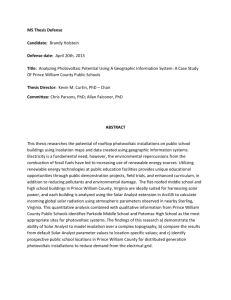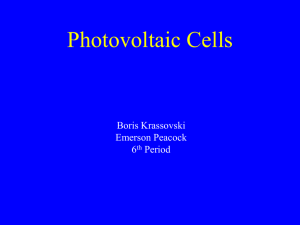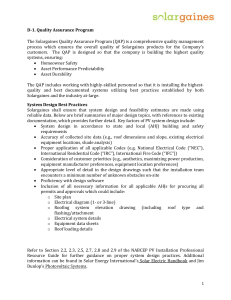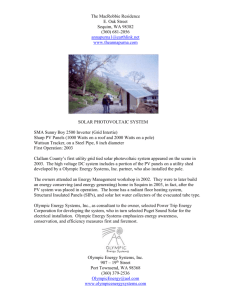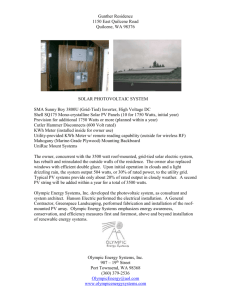Solar Energy Glossary - Solar Solutions & Distribution
advertisement
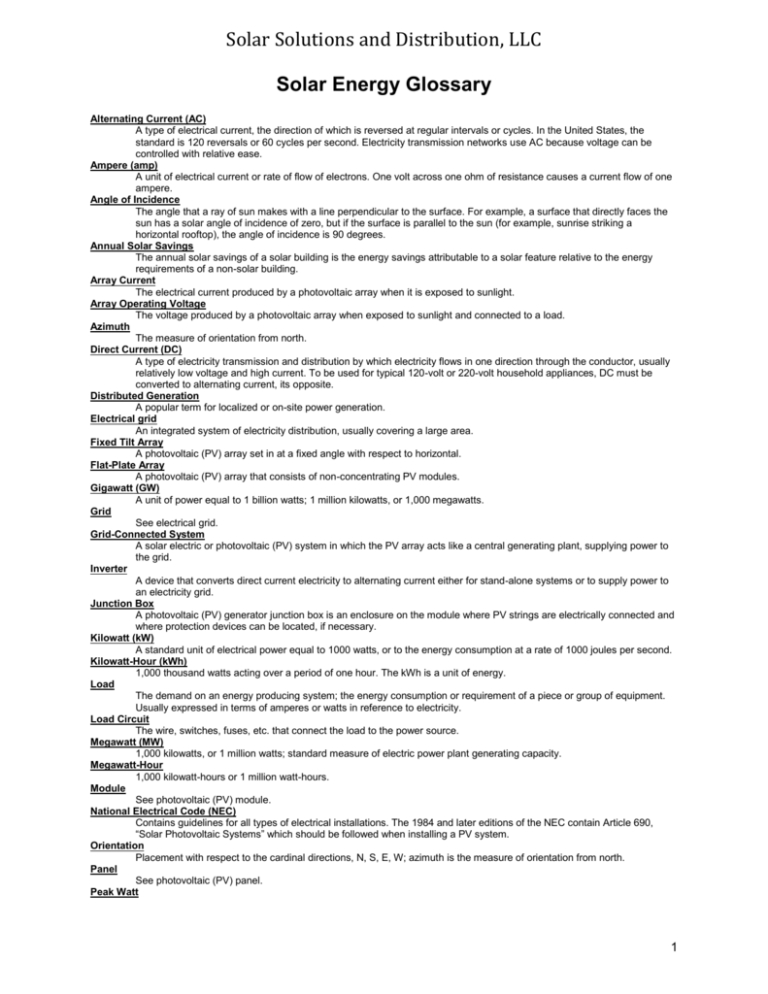
Solar Solutions and Distribution, LLC Solar Energy Glossary Alternating Current (AC) A type of electrical current, the direction of which is reversed at regular intervals or cycles. In the United States, the standard is 120 reversals or 60 cycles per second. Electricity transmission networks use AC because voltage can be controlled with relative ease. Ampere (amp) A unit of electrical current or rate of flow of electrons. One volt across one ohm of resistance causes a current flow of one ampere. Angle of Incidence The angle that a ray of sun makes with a line perpendicular to the surface. For example, a surface that directly faces the sun has a solar angle of incidence of zero, but if the surface is parallel to the sun (for example, sunrise striking a horizontal rooftop), the angle of incidence is 90 degrees. Annual Solar Savings The annual solar savings of a solar building is the energy savings attributable to a solar feature relative to the energy requirements of a non-solar building. Array Current The electrical current produced by a photovoltaic array when it is exposed to sunlight. Array Operating Voltage The voltage produced by a photovoltaic array when exposed to sunlight and connected to a load. Azimuth The measure of orientation from north. Direct Current (DC) A type of electricity transmission and distribution by which electricity flows in one direction through the conductor, usually relatively low voltage and high current. To be used for typical 120-volt or 220-volt household appliances, DC must be converted to alternating current, its opposite. Distributed Generation A popular term for localized or on-site power generation. Electrical grid An integrated system of electricity distribution, usually covering a large area. Fixed Tilt Array A photovoltaic (PV) array set in at a fixed angle with respect to horizontal. Flat-Plate Array A photovoltaic (PV) array that consists of non-concentrating PV modules. Gigawatt (GW) A unit of power equal to 1 billion watts; 1 million kilowatts, or 1,000 megawatts. Grid See electrical grid. Grid-Connected System A solar electric or photovoltaic (PV) system in which the PV array acts like a central generating plant, supplying power to the grid. Inverter A device that converts direct current electricity to alternating current either for stand-alone systems or to supply power to an electricity grid. Junction Box A photovoltaic (PV) generator junction box is an enclosure on the module where PV strings are electrically connected and where protection devices can be located, if necessary. Kilowatt (kW) A standard unit of electrical power equal to 1000 watts, or to the energy consumption at a rate of 1000 joules per second. Kilowatt-Hour (kWh) 1,000 thousand watts acting over a period of one hour. The kWh is a unit of energy. Load The demand on an energy producing system; the energy consumption or requirement of a piece or group of equipment. Usually expressed in terms of amperes or watts in reference to electricity. Load Circuit The wire, switches, fuses, etc. that connect the load to the power source. Megawatt (MW) 1,000 kilowatts, or 1 million watts; standard measure of electric power plant generating capacity. Megawatt-Hour 1,000 kilowatt-hours or 1 million watt-hours. Module See photovoltaic (PV) module. National Electrical Code (NEC) Contains guidelines for all types of electrical installations. The 1984 and later editions of the NEC contain Article 690, “Solar Photovoltaic Systems” which should be followed when installing a PV system. Orientation Placement with respect to the cardinal directions, N, S, E, W; azimuth is the measure of orientation from north. Panel See photovoltaic (PV) panel. Peak Watt 1 Solar Solutions and Distribution, LLC A unit used to rate the performance of solar cells, modules or arrays; the maximum nominal output of a photovoltaic device, in watts under standardized test conditions, usually 1,000 watts per square meter of sunlight with other conditions, such as temperature specified. Photovoltaic(s) (PV) Pertaining to the direct conversion of light into electricity. Photovoltaic (PV) Array An interconnected system of PV modules that function as a single electricity-producing unit. The modules are assembled as a discrete structure, with common support or mounting. In smaller systems, an array can consist of a single module. Photovoltaic (PV) Module See photovoltaic (PV) panel. Photovoltaic (PV) Panel Often used interchangeably with PV module (especially in one-module systems), but more accurately used to refer to a physically connected collection of modules (e.g., a laminate string of modules used to achieve a required voltage and current). Photovoltaic (PV) System A complete set of components for converting sunlight into electricity by the photovoltaic process, including the array and balance of system components. Renewable Energy Credit or REC REC is the renewable attribute of renewable energy. A contractual right to the full set of non-energy attributes, including any and all credits, benefits, emissions reductions, offsets and allowances, howsoever entitled, directly attributable to a specific amount of electric energy generated from an Eligible Renewable Energy Resource. One REC results from one megawatt-hour of electric energy generated from an Eligible Renewable Energy Resource. Solar On-site Renewable Energy Credit or SO-REC A REC created by an On-site Solar System. Standard Rebate Offer or SRO A standardized incentive program offered by a QRU to its retail electric service customers for On-site Solar Systems that do not exceed 100 kW per installation. Tilt Angle The angle at which a photovoltaic array is set to face the sun relative to a horizontal position. The tilt angle can be set or adjusted to maximize seasonal or annual energy collection. Tracking Array A photovoltaic (PV) array that follows the path of the sun to maximize the solar radiation incident on the PV surface. The two most common orientations are (1) one axis where the array tracks the sun east to west and (2) two-axis tracking where the array points directly at the sun at all times. Tracking arrays use both the direct and diffuse sunlight. Two-axis tracking arrays capture the maximum possible daily energy. Two-Axis Tracking A photovoltaic array tracking system capable of rotating independently about two axes (e.g., vertical and horizontal). Watt A unit of measure of alternating current electric power at a point in time, as capacity or demand. For the purposes of measurement of output from Solar Renewable Energy Systems used in the solar program, the watts referenced 2


